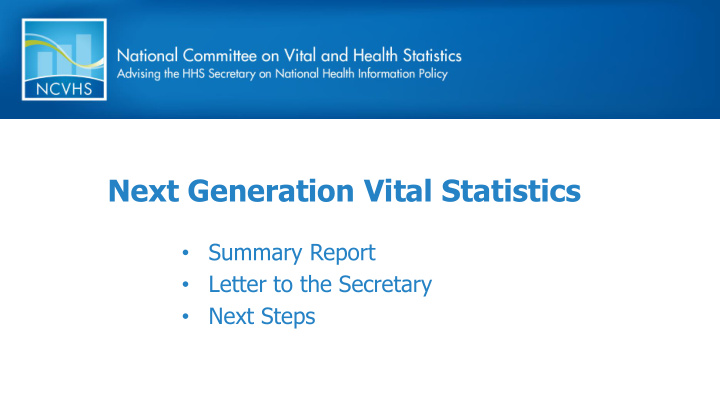



Next Generation Vital Statistics Summary Report • Letter to the Secretary • Next Steps •
Hearing Summary (Table of Contents) Executive Summary I. Introduction and Overview of the Hearing II. The Vital Records and Statistics System (VRSS) Landscape Vital Event Registration Vital Statistics Information Flow in a Federated System III. The Uses of Vital Record Data and Vital Statistics Health Care and Public Health Population Estimates Identity Establishment & Verification, Death Notification, Fraud Prevention
Hearing Summary (Table of Contents) IV. System Challenges Costs and Financing Complexity, Inefficiency, and Gaps in Technology Variability and Performance Gaps among Jurisdictions Quality Concerns Lack of Training for Data Providers and Collectors Barriers to Data Access Challenges Related to Mortality V. Looking to the Future Vision Possible Strategies Next Steps
Hearing Summary (first page) Executive Summary Vital records data are the foundation for essential functions at local, state, territorial, and federal levels but the system is highly vulnerable. Federal leadership is needed to secure the vital records and vital statistics data collection network as a sustainable, reliable resource. I. Introduction and Overview of the Hearing Vital records, the building blocks for vital statistics, are the legal registration of major life events for individuals, including birth, fetal death, marriage, divorce, and death. Vital statistics, the compilation of de-identified vital records, are the quantitative data concerning vital events in a population, such as the number of births and the death rate. Together, the Vital Registration and Statistics System (VRSS), play a critical role in public health surveillance and evaluation of the effectiveness of health care and health financing, and are relied on for identity establishment, research, commerce, and many other essential uses.
Hearing Summary (ending) Based on the hearing and subsequent analysis, the Committee has determined that federal leadership is needed to: • Convene the multiple stakeholders to modernize the federated VRSS. • Develop business models to better align payment with uses and distribution of payment to cost centers. • Systematically obtain systematic information regarding the current business model from each vital registration jurisdiction to inform this work. • Modernize laws, technology and process related to VRSS. • Train people collecting and contributing VRSS data and credential the jurisdictional vital registration systems.
Letter to the Secretary Present full letter here
Next Gen Vitals: Ideas for next steps • Await HHS Secretary’s response to the Committee’s letter, hearing summary report and follow-up report authored by Dr. Parrish • Meet with NCHS leadership to ensure Committee’s work is supportive and not duplicative • Lay out specific projects that came out of hearing discussions as options for the Committee to pursue • Revisit issues not addressed in the 2017 vitals hearing, e.g., data quality, NVDRS • Put Next Gen Vitals on “pause” – focus on Data Access project for next 5-6 months and then reassess
Next Steps: Scoping Decisions • Breadth • Far reaching/systems approach (separating vitals records from public health surveillance) • Incremental/smaller fixes approach (support of model law) • Topic • Focused (e.g., integration of Medical Examiner/Coroner case management systems with EDRS) • General (more federal support of vital statistics system/vital records offices) • Portion of the system • Strictly vital statistics (increase timeliness/specificity/quality) • System as a whole (develop business model for VRO) • Level of Detail • Specific (data input/feeds and data element standardization) • General (conceptual framework into which others will supply the details) • Timeline • Long term, short term, or a combination
Vision for Vital Records & Statistics Modernization • Establish nationally-approved performance standards (e.g., timeliness and quality) for credentialing jurisdictions against minimum standards • Establish training programs for data collectors, providers, and processors to increase data quality and timeliness • Establish a nationally-approved model vital record and vital statistics law • Maximize use of vital records while ensuring privacy and confidentiality • Develop better aligned business models to build and sustain a modern, federated vital statistics system • Evaluate and pilot alternative models for collecting, processing, and disseminating vital records and statistics data • Establish and sustain a near, real-time vital statistics system
Vision for Enhanced Vital Records Electronics Systems Establish systems at the jurisdictional level that: • Are statewide and include a preponderance of critical data providers • Are interoperable with other key electronic systems, e.g., medical examiner/coroner, EHR, public health surveillance, NVSS • Can electronically exchange information in near real-time to authorized partners and users • Maximize collaboration across states to control costs and enhance flexibility • Maximize efficiency of workflows in collecting, processing, amending and issuing certificates • Are flexible and accurate during crisis events, e.g., hurricanes, opioid
Recommend
More recommend